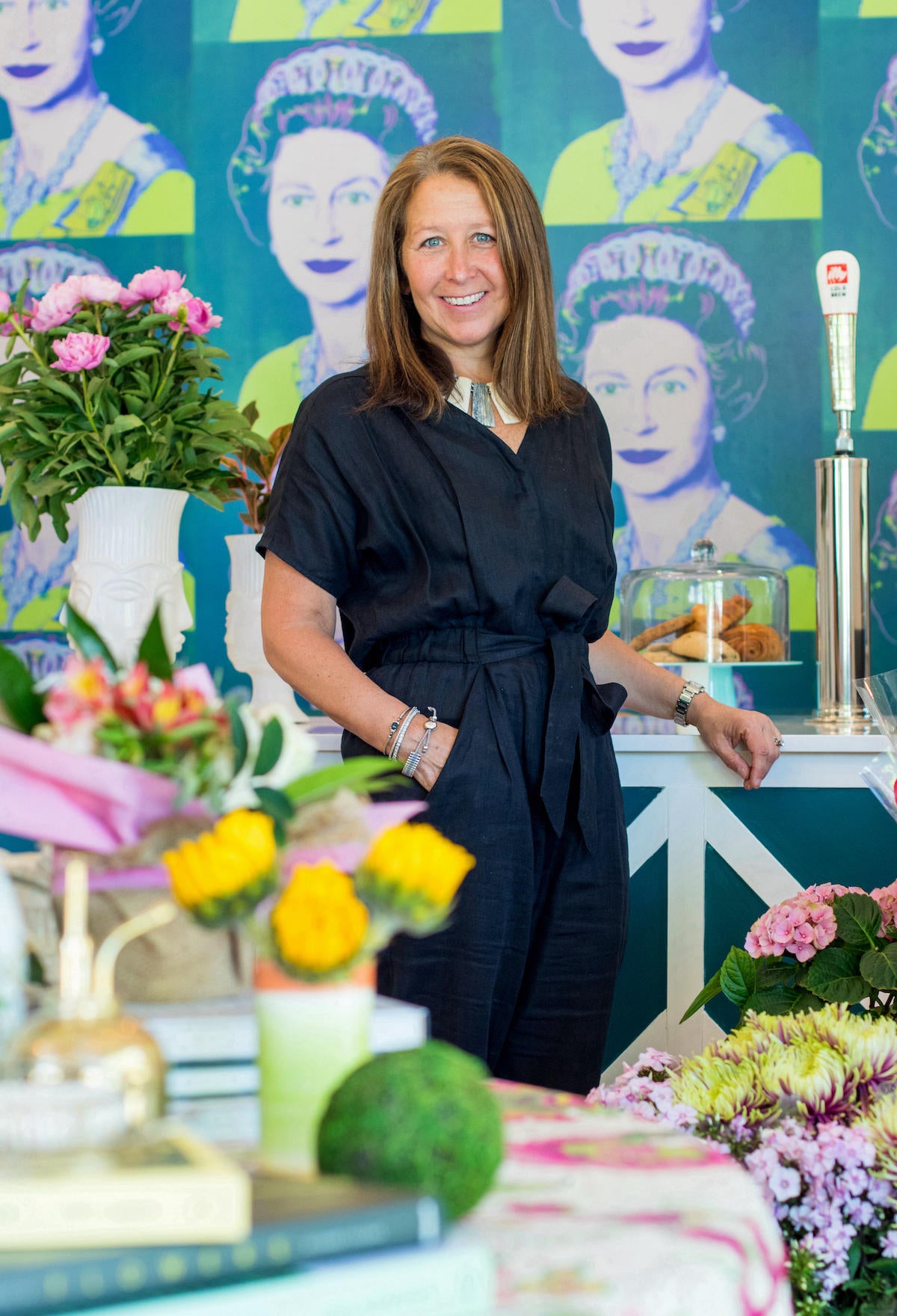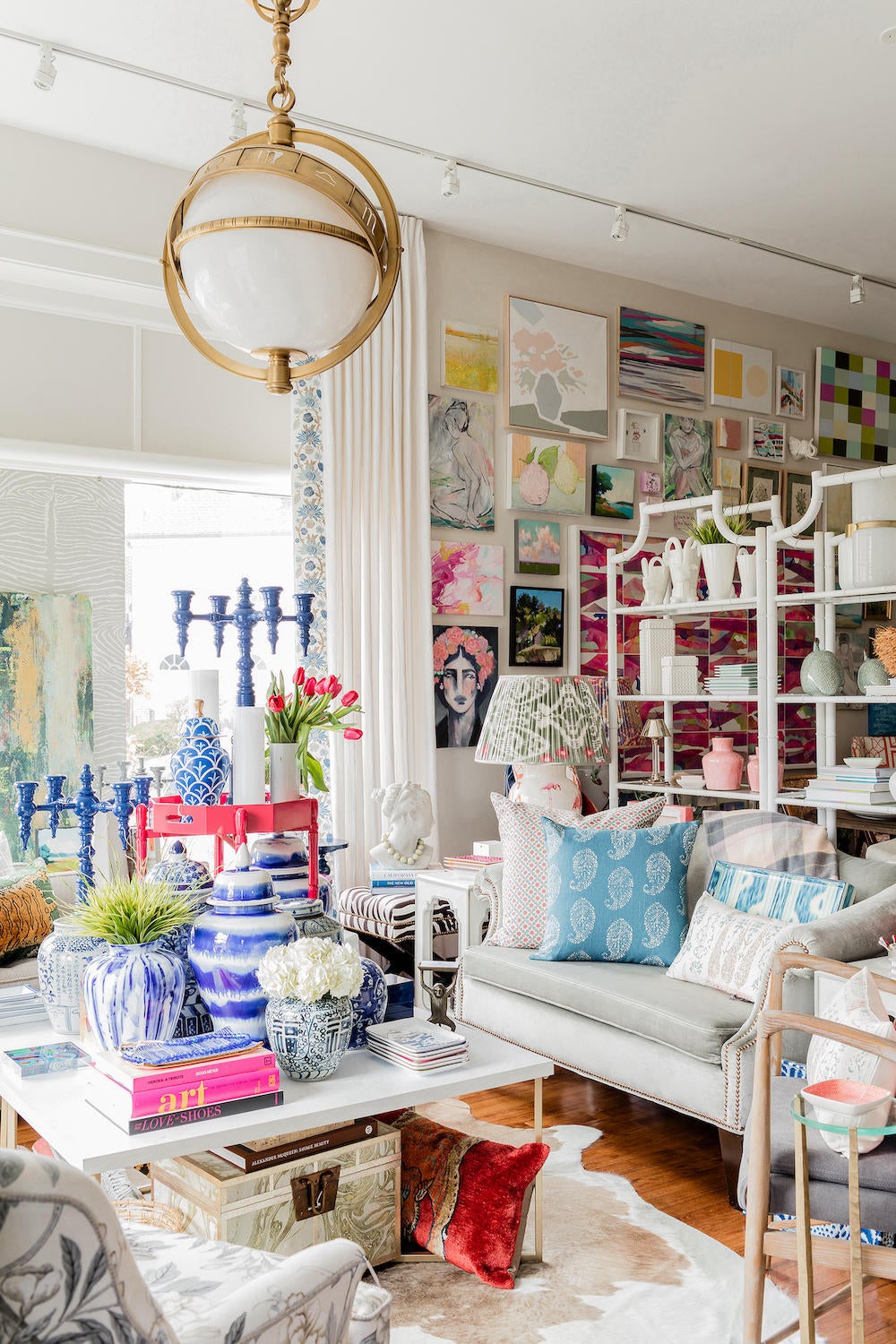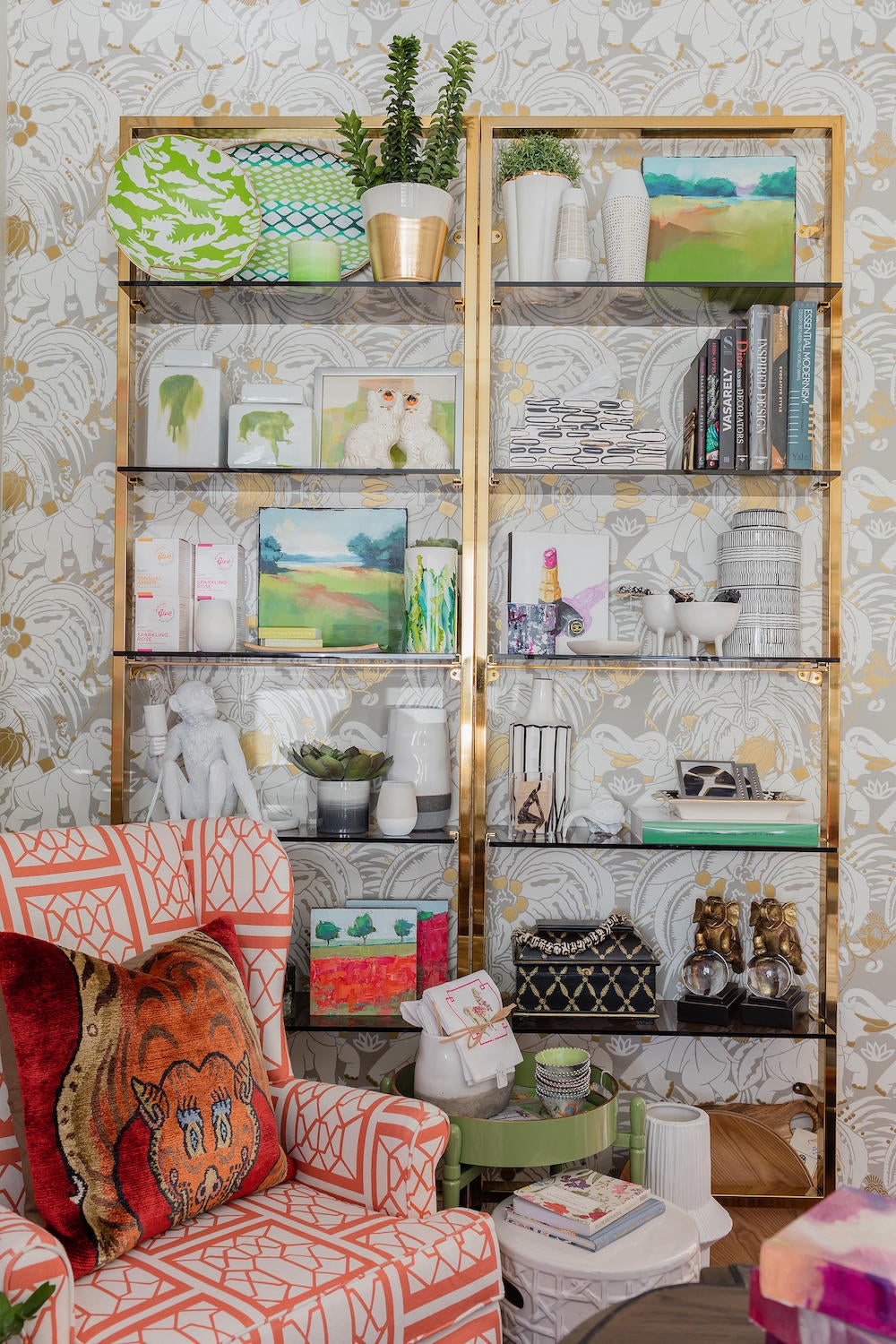In Business of Home’s series Shop Talk, we chat with owners of home furnishings stores across the country to hear about their hard-won lessons and challenges, big and small—to find out what they see for the future of small industry businesses like theirs.

This week, we spoke with Elizabeth Benedict, whose career took her from the finance world to design, and from the U.S. to Asia and back. Her retail showroom in the Boston suburb of Chestnut Hill, Elizabeth Home Decor & Design, transformed as well: She expanded in 2021 to add an adjacent coffee and flower shop, Elizabeth Home Petals & Press. Here, Benedict discusses growth at a time of personal devastation, why coffee is good for selling furniture, and how she stocks the store during the supply chain crisis.
What brought you to the design world?
My professional background was originally in financial services. My first job after college was with Brown Brothers Harriman, and then I worked for a hedge fund. When we first got married, my husband got offered a job in Hong Kong, and I continued my career working for Credit Suisse there. But he was traveling all over Southeast Asia and I was missing the opportunity, not only to be with him, but to see the region. I left my job and took a part-time position at a little design studio in Hong Kong. The owner had a retail shop, and she asked me to source for the store when I was traveling with my husband. I didn’t know anything about design or how to source—or what brocade fabric was compared to a dupioni silk—so I joined the Hong Kong Textile Society. I took a bunch of classes, and I really dove in. I started to send things back to New York, and did a few trunk shows under the name Essential Asia. Most of it was soft goods and textiles. The partner of a friend I grew up with was the buyer for Dean & DeLuca in New York at the time, and he bought my whole line ahead of the holidays. That was really exciting. I felt like, “OK, this could be a great career.”
Then my husband’s contract was up and he had a job offer in Boston, so we moved there. At this point, I’m pregnant, and I’m wondering what I’m doing with myself, because I wasn’t going back to finance. Between having my kids, I took night classes at New England School of Art and Design and got my certificate in decorative arts. We lived in Brookline in a little apartment building, so I started with apartments and urban design. I met a contractor who was doing a big project in Beacon Hill converting some old apartments to luxury condos, and he was looking for somebody to do the common spaces as well as model units. I had never worked with a designer, I had no idea what I was doing. I think I only got the job because my design bid was $5,000.
How did the store come about?
When I started my career, my studio was all happening in my house, in a home office, and it was awkward to have clients over. I started looking for a space—not even a retail space, more of an office. But this little retail shop became available two blocks from my house, and I said, “Okay, I’ll take that.” I just wanted to spread out a bit, but it had a storefront. The store is a sweet little house, a cottage. It’s actually the only retail space for like a mile.
I set up the space to feel more like a house, with a living room and a dining area. I used to invite my clients to meet there, and it gave me more credibility. I shopped for it the same way I would shop for myself or a client. Over the years the studio became more of a shop, and our whole workspace moved down to the basement, but we were still only half the building. The other half of the building was a yoga studio, and when COVID happened, she could no longer hold classes. It was then that I said, “I might as well take the whole building.” And then, when the whole world shut down, I lost my mom to COVID the first week.
Oh, I’m so sorry.
It was devastating. The office was closed, and my four kids and husband were all stuck at home. I would just come into the studio and putz around. None of our clients were doing anything, and I had no idea what was going to happen to our business. A friend of mine was an Illy coffee exec, and when [the yoga studio went] out of business, I said, “I think we should take the space and open a coffee shop, that way we’d be essential.” It would get people out of the house [if] they were tired of being home. So she got Illy to partner with me—it took a while to build because we had to get all the permits, but we have a courtyard and we decided to put in a to-go window. We expanded the design store to e-commerce as well, and it ballooned. Somebody came in the other day and bought a bar cart, but she initially came in for a cookie.
Do the spaces flow into each other? Can you take a cup of coffee and wander around?
I wanted it to be two separate spaces, two different identities, but they’re both Elizabeth Home. One is Elizabeth Home Petal and Press, which is the coffee and flower shop, and the other side is Elizabeth Home Decor and Design, the incorporated name I’ve had for 16 years. When you come through the front door, you can go either direction. If I want, I can shut down the Decor and Design side, and put up a “Call for an appointment” sign, but as long as somebody’s in the building, the whole thing is open.


Who is your typical customer?
Our strongest customers are the trade, but now word’s getting out. A lot of neighborhood people come in for coffee. We have one woman who comes every week because she says she’s only allowed to buy one thing a week. It’s fun to have regulars now. We don’t ever buy mass quantities of anything, and I’m really selective in what I bring in, so the stock changes. When something goes out, rarely is it restocked with the same thing. So every week, we really do have something new to offer.
Is there an item you can’t keep in stock?
For the Petal and Press side, our bestsellers are our white vases. We source them from a Canadian company called Torre & Tagus. They look great in a photo shoot, they look good in anyone’s kitchen. It’s a great gift, because it doesn’t have to go with anything, and with our cut flowers, it’s an easy grab-and-go. We can’t ever keep them in stock.
Is there a particular vendor you adore?
Our bestselling vendor is a ceramicist named Elena Boiardi, who we met at a pop-up a couple of years ago at the Boston Design Center. She does handpainted shagreen patterns on pottery, and now has a cult following. She only [sells] wholesale to four stores, and we cannot keep her stuff in stock for more than a week. For each of the stores that she sells to, she does something exclusive; for us, she makes creamer and sugar sets. She’ll drop off 20 items, and within a week we’ve shipped them all over the country.
What’s your favorite piece in the store right now, something that makes you smile every time you pass it?
I love vintage trinket boxes, Limoges-type of things. They’re so cute on a book or on the shelf. I found this little butterfly Cartier pill box recently—my grandmother had the same one, and I have hers, but this one’s been here for about three months. I thought someone would swipe it but it’s still here, and I’m almost happy—it makes up a whole vignette on that shelf.
What’s the advice you would give yourself if you could go back to opening day?
Not to expect it to take off so quickly. And not to stray from the way I want to do it. I’m not a big-box store, so I’m not going to act like one. Every time I try to get on somebody else’s bandwagon, I realize it’s best to stay true to the way I want this place to function. When I try to bring in product I think somebody [else] would like, that stuff sits there longer. It really is an extension of my brand and my services, because I’m buying things that I would buy for my clients. I’m buying what I would buy for myself.
What’s your biggest everyday challenge, and what’s your biggest existential challenge?
It’s not staffing, because I love my team and I have a great group of people who work here, but it’s getting them to see the store through my eyes. I’m like the passive-aggressive parent who expects the kids to clean up their room or put it back the way that I would do it. I have [what I want] in my mind. When I come in sometimes it’s frustrating that the store’s not looking as tight as I want it to, or the vignettes aren’t quite what I would do. I’m still running my design business so I’m hardly here, and when I come in and the place is out of whack it’ll ruin my day.
And then existentially—will customers like it? Does my vision translate into a sellable vision? Am I going to stay in business? This is really only 10 percent of my business, but with COVID and supply chain issues, this should be 30 percent of my business. We have stock! This is all grab and go. What keeps me up at night is waiting nine months for things and then not being able to deliver. It’s feeling super vulnerable to these lead times, and delivering the bad news to the clients. So the focus on the shop now is the complete opposite: You can have it now. We only shop from people who have deliverables, who can ship.

How are you communicating these supply chain concerns to your customers?
We’re super transparent anyway, but it was letting them know. We started sending them all of the Business of Home articles [on the issue]! We were so thankful it finally hit national news, because [customers] are always a little suspect. “Did you really place the order? Why is it taking so long?” You never want somebody to doubt you. The price points online—I want [customers] to understand they’re not getting a deal, they’re just paying for shipping. Last week, I had four phone calls in one day with smaller vendors because the shipping fees are now coming in at 50 to 60 percent of wholesale. You can’t absorb that. It’s just an add-on: 24 percent of the product cost, then a drop-ship fee, a fuel surcharge is another 8 percent, and then you’re getting hit with a small-order fee because they can’t fulfill the whole order—they’re only shipping out part of it.. It’s crazy. I said, “If it’s a small order, this can go in a UPS box with some bubble wrap and cost $19!” But it costs $85 because that’s their formula. It’s going to get to a point where people are going to wait or stop buying. I’m telling my clients to wait. I could be shooting myself in the foot, but it’s the right thing to do.
What’s a challenge unique to the Boston area that people elsewhere might not experience?
That we’re frugal Brahmins. Where I am is very academic. There are a lot of people here on an expat package, two-year contracts, a lot of students, so I don’t think their houses are as important as, say, somewhere in the South. A lot of the layering doesn’t happen, so people have to be talked into the extra step. It gets better as you get further west and into the real suburbs, but in the city proper, they’re thinking, “Do I really need that?” If you’re in downtown Boston, you’re eventually moving to a house. They like their artwork here better than tchotchkes and accessories. On the coffee shop side, we feature one artist at a time—mostly emerging artists or local artists, so it’s like a little show. On the Decor and Design side, we have a collective of art, probably 100 pieces from artists across the country.
What is the future of small businesses like yours?
I wish there were more here in Boston. Like I was saying with the white vases from Torre & Tagus—I’ll walk into HomeGoods and sometimes they’re there. So it’s making sure you’re bringing in quality things that somebody’s not going to buy on the internet or at HomeGoods. More and more, people want the experience of going into a store. They appreciate seeing smaller venues from different points of view. When you come in here, there’s equal parts vintage and new, so it takes a while to stroll through and appreciate it.

Now, I just want to put my eyes somewhere that isn’t my home. I want to spend time in a beautiful place!
Small stores are storytellers, right? There’s a reason behind what they bought, why they bought it and how they put it together. The coffee shop is a nice add-on, because it gives people a reason to linger. It takes time to make an espresso or cappuccino, and if you offer them a place to enjoy it, that also turns them into a client or a customer. So we’re open to all avenues. We lend to the trade. We have a coffee shop. We have flowers. We just try to round it out so it’s an experience
What’s a great day as a shop owner?
I really do love my shop. I love the mornings, when I look at our sales report. It’s fun seeing what people pick because it’s like, “Oh, they like me! They picked that.” In the sales report, I’ll sort of giggle, like, “Oh, my gosh, that really sold!” We bought these funny cowboy spurs for the back of your boots. I put them on top of a book, and they went out within a week. It made me want to know who bought it and what they were going to use it for. Do they have ties to the West? I bought it because I went to school in Colorado, but what’s their story?
Homepage photo: The interior of Elizabeth Benedict’s Boston-based showroom, Elizabeth Home Decor & Design | Courtesy of Elizabeth Benedict






















